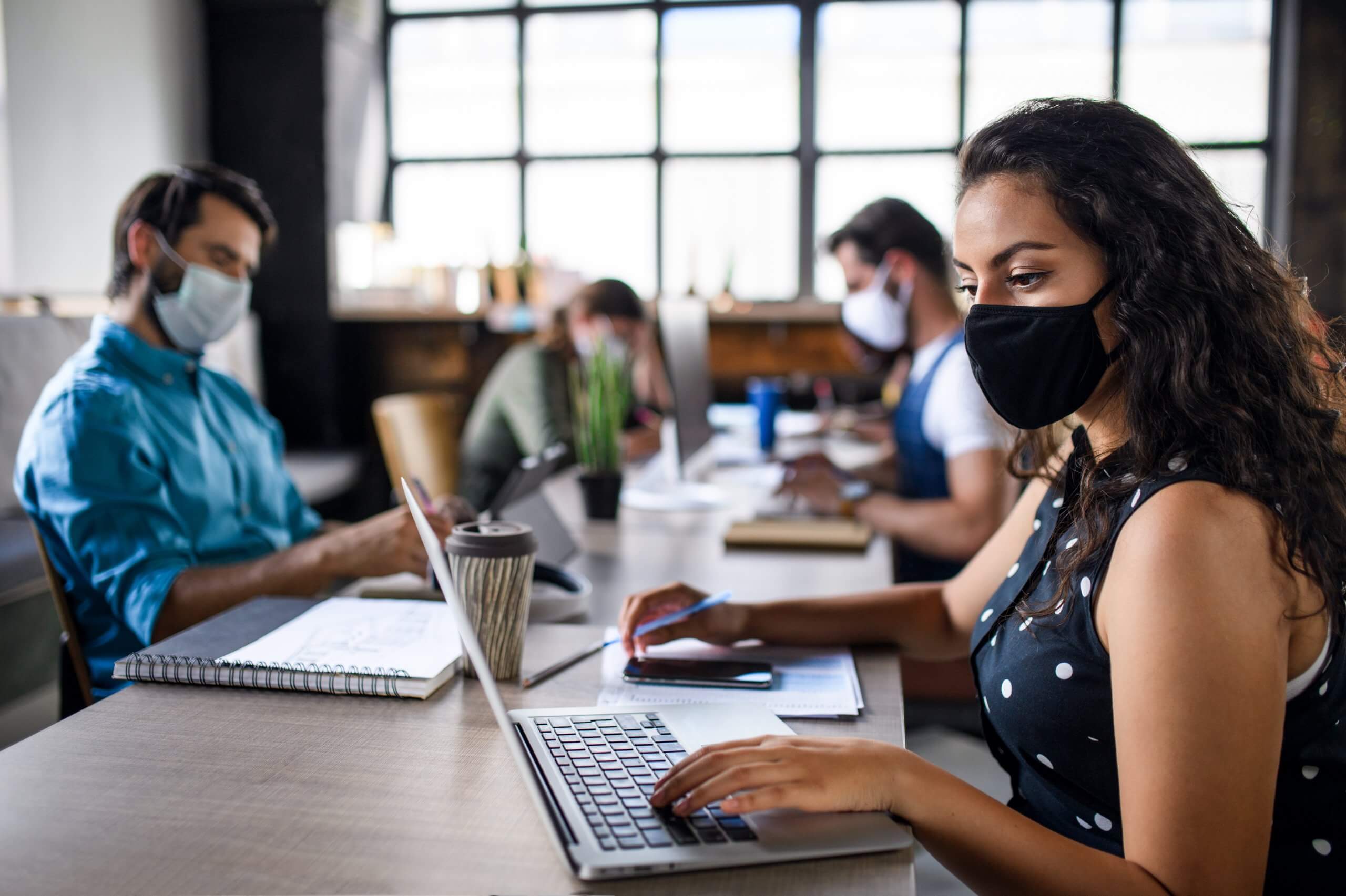We spend a lot of our time indoors. A shocking Environmental Protection Agency (EPA) statistic estimates that 90% of our daily lives are spent inside. That amount of time spent indoors means the quality of the air we breathe indoors matters. Most of us spend the weekdays split between home and work. Thus, the focus is on home air quality and workplace air quality.
Currently, that setup is a bit different of course. With a majority of Americans still working from home, work and home are the same location. But that number is changing, and seems to be an imminent shift for many as employers look to bring employees back to offices, buildings and facilities across the country. What does the return to work mean for your health and safety?
Why Does Workplace Air Quality Matter?
The answer may seem obvious. Most likely, your response to this question falls under the category of health and safety. If you were asked this question before 2020, your answer would likely be a bit different. Whether you never had a care about indoor air quality before the pandemic, or can list all the ways indoor air quality impacts cognitive performance, we bet it’s on your mind now.
Return to Work
The return to work campaign is the first reason workplace air quality matters. In a year dominated by discussions of health, airborne transmission, physical distancing and what it means to be in public spaces, the idea of returning to offices and buildings has naturally resulted in mixed feelings. Some are ready to resume office life and rejoin the social collective. A majority, however, are not. Those that are enjoying working from home don’t want to lose their newfound flexibility or valuable time spent with family. For others, it all comes down to health.
Indoor Air Quality: A Top Employee Concern
Returning to the workplace and operating in the new normal means indoor air quality and building health are top concerns for many employees. They should be of equal concern for office managers and facility coordinators. Considering the gravity of airborne transmission, air quality and environmental health have a huge impact on a company’s health, safety and success. Employees recognize this. A recent Envoy survey found that 66% of employees feel some level of worry about returning to work, specifically citing health and safety reasons. Another survey, by McKinsey & Company, found that almost 30% of respondents would likely switch jobs if their employer returned to full-time on-site work in the near future.
In our new survey on #remotework, more than a quarter of respondents said that they would consider switching employers if their organization returned to fully on-site work.
— McKinsey & Company (@McKinsey) April 2, 2021
Learn more about what employees want from the future of work 👉 https://t.co/8JpHpRg39j pic.twitter.com/guGofuJPUr
Another evident survey takeaway is the desire for clear communication. Employees want a solid plan and vision of what the return to work will look like from employers. They want to know what measures were taken in their absence to create a healthier work space.
Occupational Health and Safety
Though these topics are in focus currently, they are not new concerns. The end of April celebrates World Day for Safety and Health at Work, a United Nations designated day to recognize the importance of occupational safety and health. This year, the 2021 report focuses on the need to strengthen occupational safety health systems, based on weaknesses that the pandemic has illuminated. The awareness day, celebrated on April 28, aligns with Worker’s Memorial Day. Supported by the International Labour Organization (ILO), it is a day of recognition for those who have died or been injured on the job. The ILO also released a report calling for “investment in occupational safety and health infrastructure and integrating it into overall national crisis emergency preparedness and response plans” to protect workers. Prioritizing indoor air quality is an important aspect of occupational health and safety.
Improving Workplace Air Quality
Regardless of what your work setting looks like, if it’s an indoor space, then indoor air quality matters. For buildings, offices and the like, the Centers for Disease Control and Prevention (CDC) recommends a layered approach. This means improved ventilation, filtration and air quality measures in addition to continued social distancing, face masks and vaccines. Let’s break down what IAQ improvements can look like in the workplace.
1. Maintenance
Despite assumptions, not every IAQ solution has to include fancy new technology. Focusing on indoor air quality can be as simple as routine HVAC system maintenance. In fact, preventative or seasonal maintenance is the first step (and an easy step!) to ensure healthy air quality and create a healthy building environment.
Your office likely needs maintenance before reopening. The degree really depends on what system usage and building occupancy looked like over the past year. Were systems completely idle for a period of time? Were essential personnel still entering the space from time to time? Was a facility manager present and routinely running building infrastructure, like the HVAC system, to keep it in good condition? All of these questions should be considered, answered and communicated to employees to ensure a healthy work space.
2. Evaluate Indoor Air Quality
For building or office managers, a formal indoor air quality assessment from a respected contractor should be the first step. For employees, the reason to advocate for a building air quality evaluation is that every building has differing systems, IAQ concerns and best solutions. An IAQ assessment provides a specific breakdown of relevant facility air quality issues and knowledgable HVAC recommendations and IAQ solutions. Plus, a formal evaluation gives employers the opportunity to provide employees with documentation that measures were taken to understand and better workplace air quality.
3. Indoor Air Quality Solutions
There are a handful of HVAC system upgrades and IAQ solutions to choose from. IAQ upgrades are particularly crucial for the workplace because it is a shared space. Without IAQ solutions, particles, pollutants and contaminants spread unchecked.
Building air quality solutions include:
Improved Ventilation
Ventilation is the best way to dilute indoor air pollution. As per the CDC, “the lower the concentration, the less likely viral particles can be inhaled into the lungs.” Increasing outdoor airflow and reducing recirculated air improves building ventilation. Another option is to install a mechanical ventilation system, which consistently circulates fresh air throughout the entire space. Also, make sure localized ventilation fans are on whenever the building is occupied (i.e. bathroom fans, kitchen fans, etc.).
Humidity Control
Another helpful IAQ option is to monitor indoor humidity levels and maintain the ideal 40-60% indoor humidity range. If your building struggles with indoor humidity regulation, whole-space humidifiers and dehumidifiers are available.
Clean Air Ducts
This is a helpful option for buildings that have truly gone unoccupied since the pandemic first began. For such spaces, air duct cleaning is a smart choice to remove dust and sanitize ductwork.
Upgraded Air Filters
Filtration is another popular pandemic air quality choice. Air filters are an important HVAC system defense. They were not, however, originally designed with occupant health and safety in mind. Upgrading to MERV-13 or the highest-rated filter that won’t reduce overall system airflow is the way to go.
Purification System
Air purifiers are also a useful and effective IAQ option. For workplaces in particular, opt for a whole-building air purifier. This targets air throughout the entire space, improving overall workplace air quality.
 Air Purification: Not all air purifiers are built the same way. Air purifiers that utilize bipolar ionization have an advantage, here’s why →
Air Purification: Not all air purifiers are built the same way. Air purifiers that utilize bipolar ionization have an advantage, here’s why →Funding for Healthy Work Spaces
When pursuing these upgrades or advocating for IAQ solutions, keep in mind that such widespread building closures are wildly unprecedented. In response, there are actually many funding options available. Make sure to research potential incentives, programs and financing options to utilize as well as federal, state or even local funding for HVAC and IAQ upgrades. After all, creating healthy buildings benefits all.
Healthy Buildings, Offices & Facilities
Pursuing IAQ solutions and HVAC system upgrades are not short-term fixes. The current focus on creating healthy buildings means more healthy facilities in the future. Choosing to upgrade your workplace or advocating for it to be done is beneficial in the present and future. Indoor air quality concerns were an issue long before COVID-19 and will reman on the public’s mind even when the pandemic is no longer the first association.






